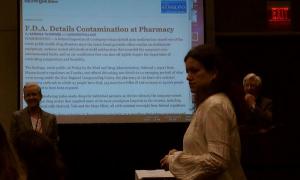By Emily Coren
In an intimate workshop designed to show writers how to transition to multimedia, Tom Linden moderated the panel, "As seen on TV & heard on radio: Science writing cross training" with panelists Cynthia Graber and Helen Chickering.Linden opened with a few funny quotes, making the audience giggle with one from Garrison Keeler, "If you watch TV news, you know less about the world than if you just drink gin out of a bottle."
Graber listed some tips for transitioning from print to radio:
-
Use short and direct sentences; get rid of clauses and commas.
-
Choose numbers carefully to maintain audience engagement.
-
Characters: Who are they and why are you using them? Use short titles when describing people.
-
On recording voice: Practice reading your story out loud. Practice reading to a friend, and when you are recording it, read it as if you were telling it to a friend sitting across from you.
-
When collecting sound clips, find sources/scientists who speak well.
-
Using intimate sound details to bring the story alive for the listener. For example, start with an establishing shot, then move to conversational voices and then to details like the clink of a fork on a plate. You can play around with theatrical sounds, but that doesn't negate the other information you are collecting.
Linden showed an example of a video clip about an invasive insect, the wooly adelgid, to illustrate how to incorporate images into stories.
"The face of the story is absolutely essential," he said, pointing out that the story is told through the arbortist observing the damage from the wooly adelgid on hemlock trees. He emphasised the visual storytelling by showing images of the arborist climbing a hemlock tree in a harness, an establishing shot describing the damage to the forest, and a close-up of what a wooly adelgid looks like.
Linden said that emotion plays a more important role in TV and radio, and the purpose of sound bites is to convey emotion, not information. Information comes from the narrator, and the scientist involved with the story is a great source for emotion. To keep your viewers' attention, add an audio or visual surprise every 15 to 20 seconds.
Chickering, a TV producer, echoed Linden's and Graber's suggestions by adding that it's helpful to keep the microphone on when the character is in an office or work setting; that you can get good clips when the character is feeling relaxed in a familiar setting.
For TV, she advised shortening the content and adding images. For example, it's best to have at least five scenes for a story lasting one minute and 15 seconds. She advised that for transitions it's useful to incorporate natural sounds, such as a heart monitor or a stream.
To practice what we'd learned, Linden led the group through an exercise of turning a New York Times article into three sentences for a TV or radio story.
Script tips for short-form television reporting
Handouts and speaker biographies

